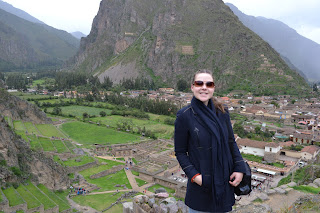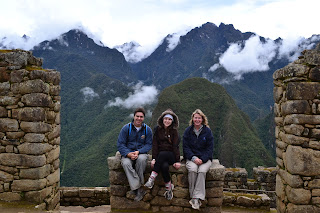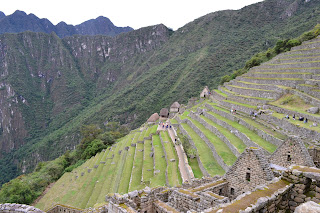Peru – The Andes
Mountains
 The first thing that you
notice about arriving in Cuzco is the altitude. It affects how you feel. Weak....
Climb the hotel stairs and you're puffing. We were given a drink from the hotel
staff straight away. It is tea made with cocoa leaves. Not bad!
The first thing that you
notice about arriving in Cuzco is the altitude. It affects how you feel. Weak....
Climb the hotel stairs and you're puffing. We were given a drink from the hotel
staff straight away. It is tea made with cocoa leaves. Not bad! After a day of
rest, Jessica, Katie and I set off on a tour of the Sacred Valley leaving Alan
in bed with a cold he had caught in Lima.
After a day of
rest, Jessica, Katie and I set off on a tour of the Sacred Valley leaving Alan
in bed with a cold he had caught in Lima. The tour guide took us to markets, ancient Inca ruins, and a silver making workshop with a shop full of lovely silver jewellery.
 The whole day was tiring because although the guide
had lots of interesting information to tell us, she alternated between Spanish
and English; so I would switch off and switch on. Inca means 'King' and the
story between the Spanish invaders, the Inca nobles and the other Peruvian
tribes was complicated. This guide told us a simple version. Our other guide on
the Salcantay trek told us more about the relationships and downfall of the 300
year old Inca Empire.
The whole day was tiring because although the guide
had lots of interesting information to tell us, she alternated between Spanish
and English; so I would switch off and switch on. Inca means 'King' and the
story between the Spanish invaders, the Inca nobles and the other Peruvian
tribes was complicated. This guide told us a simple version. Our other guide on
the Salcantay trek told us more about the relationships and downfall of the 300
year old Inca Empire.
Apparently the Spanish
explorers came across an Inca ship in the Pacific Ocean loaded with gold and
silver treasures, which they took. They came to Peru looking for more. The cemeteries
were raided because the mummified nobles were buried with treasures to take to
the spiritual world. The cemeteries were holes dug into the sides of hills
surrounding the walled towns.
The Inca king Atahualpa however, had a good
relationship with some of the Spanish and he learnt to speak the language and
even played chess. The king’s half - brother Huascar in Ecuador wanted to
acquire more territory in Peru so he gained the support of Spanish military and
gun powder was used in the battle to take over the Peruvian territory.
 All buildings
were blown up except Machu Picchu. The Inca people destroyed the seven trails
that led to the site and it was hidden. There were originally 30 million people
living in Peru before the Spanish invasion. 80% died. The Inca king was
captured and his people gathered a ransom of gold and silver treasure items.
The king was killed anyway by a Spaniard and the treasure for the ransom
disappeared. This treasure is now part of a legend about Atahualpa’s gold.
All buildings
were blown up except Machu Picchu. The Inca people destroyed the seven trails
that led to the site and it was hidden. There were originally 30 million people
living in Peru before the Spanish invasion. 80% died. The Inca king was
captured and his people gathered a ransom of gold and silver treasure items.
The king was killed anyway by a Spaniard and the treasure for the ransom
disappeared. This treasure is now part of a legend about Atahualpa’s gold.
 We set off on our adventure
in the Andes Mountains, however my stomach didn't feel great from a meal the
night before in Cuzco. I ignored it and we started walking up hills and along
steep sided mountains.
We set off on our adventure
in the Andes Mountains, however my stomach didn't feel great from a meal the
night before in Cuzco. I ignored it and we started walking up hills and along
steep sided mountains.
After lunch I got worse and I got left behind as the
others walked faster. Alan stayed with me and when we were within sight of
camp, the guide found out I was in a bad way. I started vomiting. I finished
that first day of trekking on horseback then I collapsed in my tent for the
night.
 |
| Spot Alan trekking in the wilderness. |
Just above
us the grass was dusted with fresh snow and cows clung to the steep, grassy
slopes like goats. I asked how could a cow save itself if it couldn't balance
on the slope? The answer was the condors would get it because it would be dead.
We arrived at the switchback
and I was getting slower than Alan who was struggling to breathe with the high
altitude and his head cold.
The guide, Henrik, offered the horse which had been
saved for emergencies. Our duffle bags, tents, cooking gear and food had been loaded
onto the mules and the team of Peruvian men had caught up to us. Alan refused
to get on the horse so I thought, why not! It was wonderful watching the horse
pick its way carefully through the rocks and climb the steep path. I got off at
the top and asked the man to take the horse to Alan. He didn't. Bit of a
language problem there! I watched the others climb slowly up.
We are with two
sisters from America called Katie and Caraline. They were great friends to have
on our trek.
At the pass we stood at 4600
metres. We were very close to the top of Mount Salcantay and we watched a
number of avalanches while we were in the area. Some sounded like distant
canons and others sounded like an approaching jet aeroplane. Some looked like
an explosion of snow; others looked like a snow waterfall.
I walked for the rest of the
day mostly downhill. It was difficult for everyone because you really had to be
surefooted on rocks that rolled under your feet, bogs that tried to take your
shoes off and very steep paths with flowing water. Along the way, we saw
Chinchillas bounding amongst the boulders just below the snow line.
The cloud
forest had many waterfalls to look at, however we were still walking after
twelve hours and it was getting dark. We used torches on the difficult path and
made it to camp just before it got pitch back. I was able to eat some soup. The
others had a feast because the two cooks were really good at whipping up a three
course meal for lunch and dinner. Everyone was exhausted.

Next morning our routine
began with packing our gear, the others eating breakfast, brushing teeth,
putting plastic bags over our socks and our sore feet into wet, muddy shoes. I
was too weak to walk what was predicted to be a very difficult days trek, so I
set off on horseback following the river beside the road.


I got to see a beautiful black bird with a gold patch on its back, a dead coral snake and an avocado tree. I also saw the track the others had to follow by looking across the river to the other side, but then I saw a massive waterfall and no way across. I did wonder how they would get across.
I arrived at our lunch spot
and slept on a narrow concrete bench seat. Three hours later the others
arrived. While they ate lunch I managed to eat some soup and I heard their
story. There was no path across the waterfall. They had climbed up the cliff grabbing
plants growing on the slope and Henrik said, “We'll cross here.” The group
stood to one side and unanimously thought, "No way!" Henrik started
throwing rocks into the water then he suggested everyone should leap onto the
middle rock, then leap again to the other side. Alan said he was wondering what
to say to me if one of my daughters didn't make it. Henrik did offer to stand
in the water and lend a hand.
Katie (from America) said the waterfall wasn't the worst part. The landslide was more challenging. One wrong step and you'd be gone. It was a very fresh landslide and really difficult to find your balance on moving scree.

Our tired group finished the
day at Santa Teresa Thermal springs. We soaked in a lovely pool of 35degrees
and relaxed and enjoyed each other’s company. The two sisters are great friends.
Caraline was living in Ecuador doing community work for Peace Corps and Katie was
going to follow her husband to live in Australia - Alice Springs of all places!
 We enjoyed having our first
wash at the springs as warm water gushed out beside the River Urubamba. It
tumbled and splashed over large rocks that we couldn't see, with great speed
and power. It looked deadly.
We enjoyed having our first
wash at the springs as warm water gushed out beside the River Urubamba. It
tumbled and splashed over large rocks that we couldn't see, with great speed
and power. It looked deadly.
The next day, our group
elected not to walk 25 kilometres straight up a mountain, down a mountain, just
13km along a railway track to the town of Aguas Callentes. We walked in
torrential rain beside another river with extreme rapids.
This town was really
interesting. The railway line goes right through the middle and there are
restaurants and markets, and the gushing river, all nestled in a narrow valley.
Alan and I celebrated our 24th wedding anniversary with the group in a great restaurant. I had a
little bit of appetite back.
The next morning we caught the bus up the mountain side to Machu Picchu.
Machu Picchu was awesome! We
were surrounded by tourists from all over the world and Henrik gave us a quick
tour. A Belgium couple joined in because we had camped with them one night and
coincidently bumped into them on many occasions. They were lovely people.
The ruins were from at least
the sixteenth century and they were so extensive.
We followed pathways to many
rooms with different purposes. Three thousand people once occupied the place
and it had catered for many visitors such as tribal representatives. The Incas
has defeated each tribe in Peru and united them under their rule, and
confiscated their tribal totems. We could see the niches for each totem in a
three walled structure made from stones that had been fitted together like
jigsaw pieces with earthquake proof tongue and grove joins. The foundations of
the walls were designed to allow movement as they included smaller stones
packed in sand.
There was a G shaped building that was thought to be used for
astronomy. The position of the summer solstice could be calculated by lining up
a rock with the Sun Gate. Another window looked directly east.
The nobles also
had a garden with samples of important tropical plants. Religious ceremonies were
held at Machu Picchu and at the top of a steep hill called Huayna Picchu. Katie
and Caraline walked up there. They said it was really scary but the top gave a
great view.
 |
| The alpaca says "Hello!" |
We walked to the Sun Gate and also had a great view.
It took two hours by train
and another two hours by car to return to Cuzco. From there we woke up very early
and caught our first of many planes on our way home. We thought we'd had our
last adventure and the girls and I were relaxing in the airport in Santiago,
Chile when Alan alerted us to a cancellation. That meant spending the night in
a hotel, waking up at 4.00am and checking in again! We also had a rescheduled
flight from New Zealand so another night and 4.00am wake up was required for
checking in. Our journey on the home run included Cuzco to Lima to Santiago to
Auckland to Melbourne. What an insane final trip. I certainly couldn’t count
the hours.
Altogether we have travelled
on seventeen aeroplanes and explored five countries: France, Morocco, Portugal,
Brazil and Peru. We also visited the airports of Hong Kong in China, Madrid in
Spain, Santiago in Chile and Auckland in New Zealand. Soon enough we will be in
a routine at home and this trip will be a memory. I hope you have enjoyed
reading this blog! It is only a fraction of the stories, experiences and
photos. There is a lot more to tell but you’ll have to ask!
 |
| My princess on her castle walls! |
 |
| My angel with her halo! |
 |
 |
| Cornered |
 | ||
| Chinchilla |





















































No comments:
Post a Comment